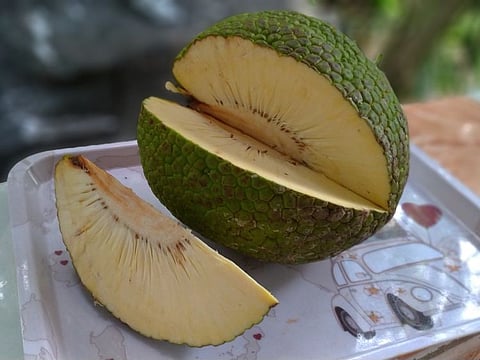Philippines looking at breadfruit to boost food security
Long ignored, fruit may soon be a common sight on Filipino dinner tables

Manila: The Philippines continues to develop breadfruit as among the alternatives to rice, the country’s staple that comprises a substantial portion of its imports.
Breadfruit, scientifically known as Artocarpus altilis and called by most Filipinos as “rimas”, is similar in appearance to jackfruit, which also grows in the same tropical conditions.
In a country where tropical fruits like mangoes, pineapple and the like, are in abundance, breadfruit is hardly known to many.
In 2013, the Department of Agriculture and its High Value Crops Development Programme funded research and development on breadfruit as well as propagation of its trees as part of the government’s food security programme.
Some 1,200 hectares were planted with breadfruit in the Bicol Region alone, but the trees were grown more as a backyard tree instead of an extensively grown crop such as those in plantations.
Seven years on, the government is continuing to implement the rimas development roadmap to ensure stable food sources given the wobbly nature of the country’s rice supply network.
Malnutrition
Bicol Region is among the areas in the country where malnutrition is prevalent and where people’s consumption of rimas would be a big boost in improving overall nutrition of the residents.
No study so far has been made available on the contribution of rimas in the region’s health and nutrition but authorities continue to find ways to encourage the development of the crop as a staple.
The Department of Agriculture’s Bureau of Agricultural Research, said breadfruit is rich in carbohydrates.
“It has low levels of protein and fat and a moderate glycemic index,” the research bureau said.
Among the products developed from rimas in the past, was breadfruit ice cream.
A report reaching Manila said that in Albay, teachers came up with a cooking contest on creative ways of using breadfruit.
Nutrition-wise, the National Tropical Botanical Garden (NTBG) said it is an excellent dietary staple and has a similar nutrition profile with other starchy staple crops commonly eaten in the tropics, sweet potato and white rice. Likewise, it is a good source of dietary fibre, potassium, calcium and magnesium with small amounts of thiamin, riboflavin, niacin and iron.
Arlene de Asis from the Department of Agriculture (DA), Bicol Region, said rimas is expected to have an impact on the region’s nutrition alleviation programme.
Long ignored, breadfruit may well be on its way to becoming a major source of carbohydrates for a number of Filipino families.
Sign up for the Daily Briefing
Get the latest news and updates straight to your inbox



